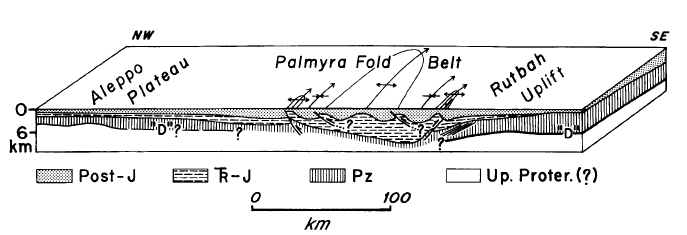
Seismic reflection and drillhole data from central Syria provide a detailed view of the subsurface structure (10-15 km depth) of the relatively little studied intracratonic Palmyride fold and thrust belt. The data set, together with surface geologic mapping, constrain a structural/stratigraphic section spanning the northeast sector of the belt and the surrounding subprovinces of the Arabian platform. The seismic and drillhole data show Mesozoic stratigraphic sequences thickening rapidly into the Palmyrides from the adjacent, arched Paleozoic platforms. Neogene (Alpine) folding and thrusting of the Mesozoic basin, as documented on the seismic data, are sharply restricted to the narrow width of the belt (~100 km), which is in contrast to the relatively undeformed, Phanerozoic strata of the platforms to the north and south.
The regional subsurface structure of the northeastern Palmyrides consists of a northeast-plunging anticlinorium whose outer flanks are marked by smaller superimposed asymmetric, anticlines associated with outward verging thrusts, giving this part of the belt a rough symmetry. The general structural style of folding is characterized by simple, relatively narrow anticlines and broad synclines that can be traced concordantly from the surface to at least 5 km depth on the seismic data--the level of any décollement appears to be below the imaged Mesozoic sequence. A fundamental feature of the surrounding Arabian platform subprovinces is a deep (~6-7 km, maximum) and pervasive bright reflection that forms the base of the reflective section of the platform but disappears abruptly beneath the Palmyrides. This basal reflector is important as a regional strain marker and may represent a Cambrian/Infracambrian carbonate-evaporite sequence or a remarkably uniform crystalline basement surface.
The seismic and drillhole data support the hypothesis of the Palmyrides beginning as a Permian-Triassic failed rift, connected to the Levantine passive continental margin, that was inverted and complexly deformed by the interfering effects of Cenozoic movements along the Dead Sea (Levant) transform fault system and the Turkish Bitlis (Tauride) convergent zone. The seismic data provide a first-time view into the extent and depth of the early basin formation and subsequent compressional deformation, and as such provide a necessary basis for constraining reconstructions of northern Middle East plate motions.
© 1990, AAPG. Reprinted by permission of the AAPG whose permission is required for further use.
American Association of Petroleum Geologists Bulletin online
Figure 20. Conceptual cross-section oriented in a dip direction through the northeastern Palmyrides. Base of Mesozoic below the belt is speculative. Important points to consider are that Mesozoic and Paleogene sequences thicken dramatically into the Palmyrides, the apparent bulge and down-bending of the "D" reflector below the southern edge of the belt may be related to an original isostatic load, and that both a south and north-vergent asymmetry characterize the Palmyrides. Caution must be used in extrapolating the structural style of the northeasternmost Palmyrides belt along the rest of the belt.
